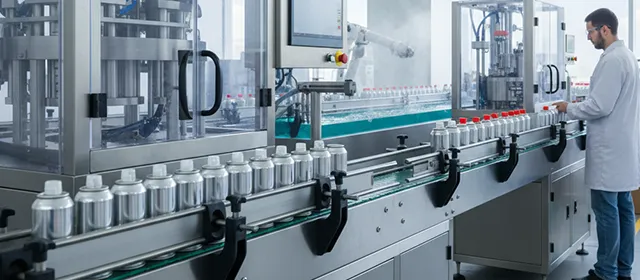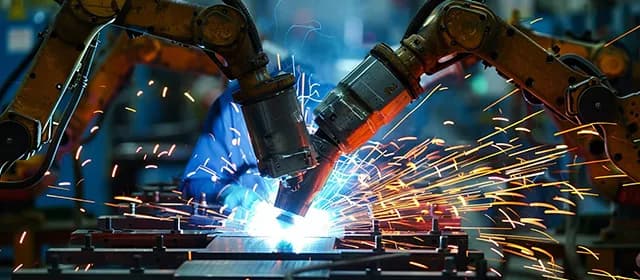Aerosol filling machines play a crucial role in the manufacturing of personal care products, household chemicals, pharmaceuticals, and industrial sprays. Downtime or quality deviations in these machines can lead to costly production losses, material waste, and regulatory noncompliance. Integration of the Internet of Things (IoT) for real-time monitoring and predictive maintenance transforms aerosol filling operations, enabling continuous oversight, early anomaly detection, and data-driven upkeep.
According to Kings Research, the global aerosol filling machines market size was valued at USD 2.08 billion in 2022 and is projected to reach USD 2.95 billion by 2030, growing at a CAGR of 4.61% from 2023 to 2030. This blog examines how IoT augments aerosol filling machinery, discusses architecture and analytics, evaluates challenges, offers examples of relevant industrial developments, and outlines a path forward.
Role of IoT in Aerosol Filling Machines
Aerosol filling machines incorporate multiple subsystems: gas charging, liquid dosing, mixing, valve assembly, sealing, and quality inspection. Critical parameters such as pressure, flow rate, temperature, valve torque, vibration, and cycle counts must remain within tight tolerances.
Embedding IoT sensors throughout these subsystems provides granular, continuous data streams. Real-time monitoring captures deviations immediately, pressure drift, actuator strain increase, valve leakage, or motor anomalies. Aggregating that data enables insight into mechanical health, quality variance, and process stability.
IoT in industrial settings underpins asset tracking and predictive analytics. An academic study presents a real-time predictive maintenance system combining IoT sensors and machine learning for industrial equipment monitoring, detecting early signs of failure. Those generic models are applicable to aerosol filling in factories where many machines operate simultaneously on tight schedules.
What Is the IoT Architecture Behind Aerosol Filling Machines?
IoT architecture for aerosol filling machines generally consists of three layers: device (sensor/actuator), edge computing (gateway or local processing), and cloud or enterprise backend (analytics, visualization, planning). Sensors sample data at high frequency, including motor current, vibration accelerometers, and temperature probes. An edge node aggregates data, executes lightweight analytics or anomaly detection, and forwards only key summaries or alerts to the cloud.
Edge analytics reduces bandwidth needs and latency. Anomaly detection models running locally can trigger alarms or automated adjustments without waiting for remote processing. Cloud systems accumulate historical data, refine models, and coordinate trends across multiple machines or sites. In some IIoT deployments, real-time condition monitoring plus AI is the next generation of predictive maintenance, making sense of real-time signals.
Layered architecture must also handle connectivity disruptions. IoT gateways may buffer data during network loss and forward once connectivity is restored. Redundant paths (wired industrial Ethernet, WiFi, cellular) ensure robustness in factory environments.
Machine controllers or PLCs integrate status signals from IoT layers. That integration enables model-driven control adjustments, e.g., reducing fill speed if vibration crosses a threshold or scheduling cleanup cycles if valve torque drifts.
Predictive Maintenance and Analytics for Aerosol Filling Machines
Predictive maintenance relies on anomaly detection, trend analysis, and forecasting models. Historical data provides normal operation baselines for each sensor channel and machine. Statistical thresholds or machine learning models flag deviations appearing early as precursor failure indicators.
One study proposes a predictive maintenance model for induction motors using IoT data, combining vibration, temperature, and acoustic signals for anomaly detection in real time. That approach maps well to aerosol filling machines, which contain motors, pumps, valves, and compressors. Another recent paper explores low-power spiking neural network methods for vibration-based predictive maintenance, optimizing inference energy and latency at edge devices.
Hierarchical inference models dynamically assign computation to edge, gateway, or cloud depending on latency, power, and accuracy tradeoffs. One framework achieved more than 90 percent classification accuracy in on-sensor inference mode, while cloud inference reached nearly 99 percent (Source: arxiv.org).
The machine learning engine must balance false alarms and missed faults. False positives disrupt production; missed faults lead to breakdowns. Continuous feedback loops retrain models and refine thresholds.
Integration with MES (Manufacturing Execution Systems) and historian databases helps correlate IoT anomalies with production cycles or quality defects. MES systems support combining preventive and predictive approaches using real-time monitoring of temperature, pressure, and voltage signals.
What Are the Benefits of IoT for Aerosol Filling Machines?
Real-time monitoring provides immediate visibility. Maintenance teams can detect deviations early, slight pressure drift, abnormal valve behavior, or motor heating before catastrophic failure. Predictive alerts reduce unplanned downtime, improving overall equipment effectiveness (OEE).
Maintenance becomes condition-based rather than scheduled. Wear-related components such as seals, valves, dosing pumps, or actuators receive maintenance when needed rather than on fixed intervals. Material and labor costs shrink, and maintenance resources focus where value is highest.
Quality consistency improves. Process deviations often link to predictive anomalies. For example, a drift in dosing pump flow or valve torque can translate into fill-weight variance, aerosol quality defects, or leakage. IoT data helps trace root causes and enforce tighter process control.
Life extension of equipment arises from early intervention. Wear, misalignment, or imbalance detected early remains correctable before cascading damage. Energy efficiency improves because machines running optimally waste less power; motors and pumps with misalignment or friction consume more energy. Analytics across machine fleets permit benchmarking and anomaly detection. Data from multiple filling lines or plants identifies underperforming assets, best practices, and scalability patterns.
Challenges and Considerations
Sensor reliability and calibration represent a critical challenge. Harsh factory environments (vibration, dust, aerosol particles, gas exposure) can degrade sensor accuracy. Sensor drift or failure must be detected and mitigated through redundancy or self-diagnostics.
Data volume and infrastructure demand careful planning. High-frequency readings from many machines generate large datasets. Bandwidth, storage, and compute pipelines must scale effectively without creating bottlenecks.
Model adaptability is essential. Machine variants, line changes, or formula shifts can change signature behavior. Models must evolve or adapt via transfer learning or re-training to maintain relevance. False alarms erode stakeholder confidence. Anomaly thresholds require tuning. Too many false positives prompt dismissal of alerts; too conservative thresholds miss early warnings.
Integration with legacy control systems and PLCs may require interface abstraction or middleware. Many aerosol machines use proprietary controllers; retrofitting IoT layers requires interoperability design. Cybersecurity is critical. Opening machines to IoT introduces network exposure. Encryption, access control, secure boot, firmware integrity, and intrusion detection are mandatory. Auditing and logging policies must comply with industrial and regulatory standards.
Return on investment (ROI) must be justified. Upfront costs in sensors, gateways, connectivity, analytics, and change management must outweigh downtime savings, maintenance savings, and quality improvements. Pilots must quantify these gains. Training for maintenance personnel, data engineers, and operations staff is necessary. Interpretation of alerts, threshold tuning, and fallback protocols requires human judgment as edge systems mature.
Industrial Developments and IoT Platforms
TDK recently launched edgeRX in March 2025, a machine health monitoring platform leveraging AI on edge sensor devices, offering real-time monitoring and predictive insights directly on machines (Source: www.tdk-electronics.tdk.com).
Sensata Technologies introduced wireless multi-modal IoT sensors for rotary assets under its Sensata IQ platform, combining vibration, temperature, acoustic, and magnetic sensing in a compact retrofit form for industrial motors and pumps. That solution illustrates how multi-modal IoT sensors integrate with enterprise analytics platforms to deliver predictive maintenance.
Industrial IoT initiatives emphasize democratization of machine learning, edge analytics, and sensor proliferation. Rockwell Automation notes that combining sensors, edge computing, and AI forms the next generation of condition monitoring (Source: www.rockwellautomation.com).
IoT platforms such as Siemens MindSphere offer industrial connectivity and analytics services for machine data, enabling integration of sensor data streams and analytics applications. Although not aerosol-specific, such platforms provide the backbone for monitoring, data ingestion, and dashboarding across diverse manufacturing equipment.
Emerging startups and research projects exploring ultralow-power inference (e.g., spiking neural networks) or hierarchical inference architectures point toward future low-latency, energy-efficient edge intelligence. These approaches reduce sensor energy consumption and support long-lived deployments.
Future Trends in IoT-Enabled Aerosol Filling
Advances in edge AI and TinyML, including spiking neural networks, will allow more complex inference on sensor nodes with minimal power. That trend enables near-instant detection without reliance on gateways or the cloud. Digital twins and simulation models integrated with IoT sensor data may forecast mechanical life, optimize operational parameters, and simulate failure modes under different formulations.
5G or private wireless connectivity in factories will reduce latency and enable more real-time coordination between filling machines and upstream or downstream processes. Auto-adjusting control feedback loops may emerge, where IoT systems not only alert but autonomously adjust machine parameters to optimize performance or avoid drift modes.
Standardization of machine health data formats, edge analytics APIs, and model interchange protocols may simplify integration across machines from different OEMs. Integration of AI explainability, anomaly root cause attribution, and contextual intelligence will build operator trust and reduce alert fatigue. Sustainability and energy monitoring layers added to IoT systems may optimize energy use, detect waste, and support ESG reporting.
Conclusion
IoT-enabled aerosol filling machines represent a high-impact class of industrial automation. Real-time monitoring across process subsystems and predictive analytics reduces downtime, improves quality, and optimizes maintenance spend. Edge computing, layered architectures, and hierarchical inference ensure scalability and latency control. Challenges remain in sensor robustness, data management, false alarm tuning, and cybersecurity.
Platforms such as TDK’s edgeRX and Sensata’s multi-modal sensors show how industrial ecosystems are embracing machine health monitoring. Strategic pilots and methodical scaling, combined with ongoing model refinement and integration practices, pave the path for robust, intelligent aerosol filling operations. The convergence of IoT, AI, and industrial techniques promises a future where failing machines signal repair long before breakdown, ensuring continuous, efficient production in competitive manufacturing environments.




